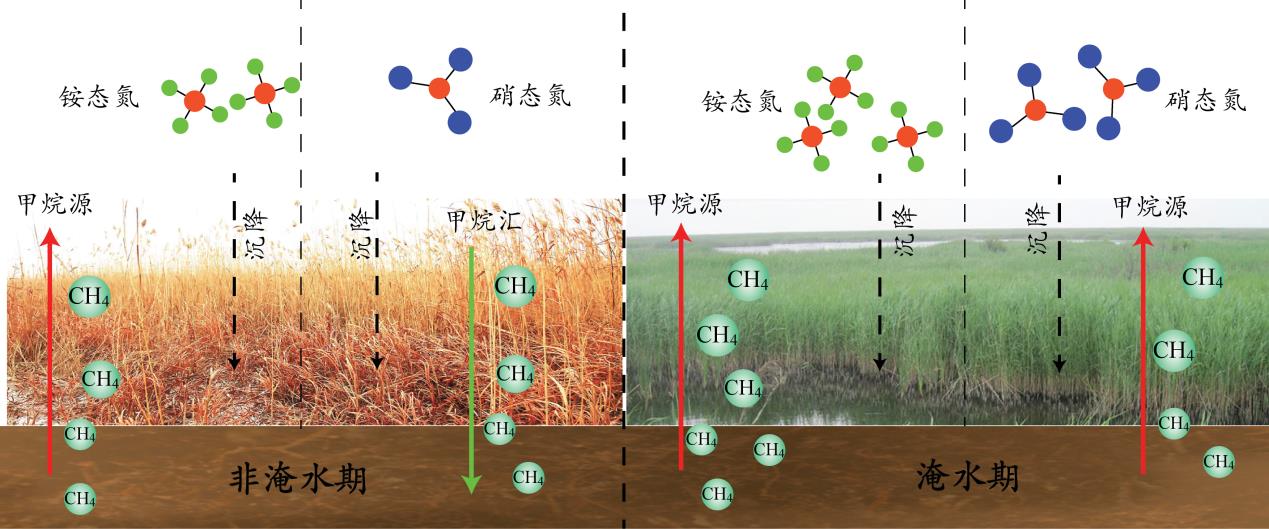| Research |
| Location:Home > Research > Research Progress |
| A new progress of wetland research on the "electron-driven methane production" mechanism by Yantai Institute of Coastal Zone Research |
Methane, which is an important greenhouse gas with higher warming potential than carbon dioxide, plays a crucial role in the global carbon cycle and the global climate change. Methane produced by natural activities has a considerable amount (about 250 million tons per year), and wetlands are the largest natural source. A variety of environmental factors can affect methane emissions from wetlands. Among them, conductive minerals (iron minerals such as magnetite) widely found in nature and increased nitrogen deposition due to human intervention are two significant potential factors. The team of “Electro-Microbial Resources and Microbial Ecological Health” in Yantai Institute of Coastal Zone Research, Chinese Academy of Sciences recently studied the effect and mechanism of nano-Fe3O4 (nano-magnetite) on methane production in the Yellow River Delta wetlands. In order to simulate the in situ environment rather than using a single carbon source as previous studies, the authors used Phragmites australis, a major plant in the Yellow River Delta wetlands, as a carbon source. The results showed that nano-magnetite could significantly improve the production rate of methane on an hour-long timescale. With the technology of natural abundance carbon isotope fractionation and 13C tracing, the increase in methane production was mainly due to the acceleration of carbon dioxide reduction. Thermodynamics, electrochemistry, model analysis and other means were used to try to find the reducing power of methanogenic process ( is the traditional hydrogen or the direct electrons?). The research showed that methane was mainly derived from "electronically driven carbon dioxide reduction", which was a new route for methane production. High-throughput sequencing analysis based on RNA level showed that Geobacter, which is caple of transferring electrons to the outside of the cell, and Methanosarcina can promote the production of methane by coupling syntrophic acetate oxidation and carbon dioxide processes. (Xiao et al., Environmental Science: Nano, 2017, DOI:10.1039/C7EN00577F)。 The team had discovered the "electronically driven methane production" mechanism (Energy & Environmental Science, 2012, 5, 8982). Furthermore, they had discovered that nano-magnetite can compensate for c-type cytochrome protein of Geobacter pili (Environmental Microbiology, 2015, 17, 648–655). This research found the phenomenon of "electron-driven methane production" in wetland environment and analyzed the influence of conductive minerals on the methanogenic pathways in the wetland. This study provided a new understanding of the methane emissions from wetlands with the participation of conductive minerals. In addition, cooperated with professor Guangxuan Han, this team have studied effects of increased atmospheric nitrogen deposition and intermittent flooding on methane emissions from coastal wetlands based on the simulation of nitrogen depositions for four consecutive years (2012-2016) (Xiao et al., Science of The Total Environment, 2017, 595, 337-343). Results showed that ammonium nitrogen increased methane emissions throughout the year. Although nitrate nitrogen had a certain promotion on methane emission during flooding period, it has less effect at unflooding period. By analyzing the structure of archaeal communities in situ under different nitrogen deposition treatments, they showed that the ammonium nitrogen increased the abundance of Methanocellaceae. It may be an important reason for the increase of methane flux. This study benefited us to understand the response mechanism of methane emissions in coastal wetlands on increased nitrogen deposition. The researches were financially supported by the National Natural Science Foundation of China, Shandong Province Outstanding Youth Scientist Foundation and the Young Taishan Scholars Programme. Papers link: 1.http://pubs.rsc.org/en/content/articlelanding/2014/EN/C7EN00577F#!divAbstract 2. http://www.sciencedirect.com/science/article/pii/S0048969717308100 |
| Appendix Download |
|
|

